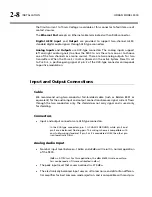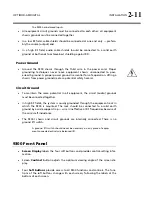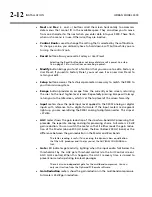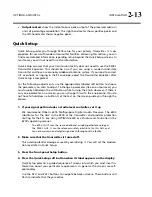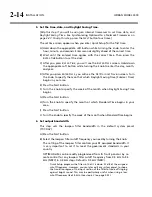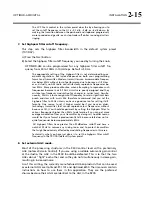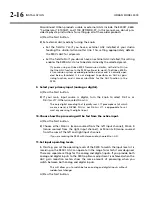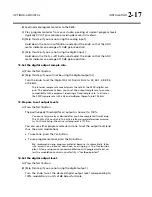
2-22
INSTALLATION
ORBAN MODEL 9300
To describe their most common application, the four system presets are
labeled TX1/DAY, TX1/NIGHT, TX2/DAY, and TX2/NIGHT, although they
can be applied in a completely general way to the requirements of your
transmission facility. System presets can be recalled by remote control
(GPI or PC Remote) and/or at preset times by the 9300’s clock-based au-
tomation.
TX1/DAY
is the default system preset and many stations will
always use it once they have set it up.
The controls within a given system preset include lowpass filter cutoff
frequency, lowpass filter shape, highpass filter cutoff frequency, positive
peak threshold (asymmetry), and four transmitter equalizer controls.
Only one system preset can be active at a given time; that preset deter-
mines the parameters applied to all outputs.
Once you have selected a system preset, that preset will be active until
you explicitly select another via the front panel, remote control, or clock-
based automation. This is true even if AC power is interrupted. However,
if clock-based automation was scheduled to recall a different preset dur-
ing the period when the 9300 was powered down, upon power-up, the
9300 will automatically recall the preset that would have been on-air at
that time if power had stayed on.
B)
Hold down the soft key under
L
OWPASS
and
S
elect the desired lowpass filter
cutoff frequency by turning the knob.
Lowpass filter cutoff frequencies range from 4.5 kHz to 9.5 kHz (NRSC) in
0.5 kHz steps. The setting of the lowpass filter controls your RF occupied
bandwidth, so it is very important to set it to meet the government stan-
dards in your country.
Note that the user processing presets can only lower the low-pass cutoff
frequency below its setting in active system preset. For example, if you
have set the low-pass cutoff frequency in the active system preset to 6.5
kHz, this can be lowered to 6.0 kHz or below in a processing preset, but
cannot be raised above 6.5 kHz. This is to prevent accidentally creating
presets that violate the occupied bandwidth standards of your governing
authority.
In Region-2 countries, we recommend configuring the 9300 for 9.5 kHz
NRSC-1 lowpass filtering (via the active system preset) and the
18dB/octave HF equalizer active with a
G
AIN
of 10dB and a
C
URVE
of 10
(via the active processing preset). This is similar in spirit to the NRSC pre-
emphasis, which also has a maximum gain of 10dB. However, it provides
more midrange boost than the NRSC preemphasis, which helps the vast
majority of radios in the field. These are narrowband radios with 2 to 3
kHz audio bandwidth (3dB down). They do not meet the EIA's AMAX
standard (or even come close to it). Of course, if you wish to broadcast
with strict NRSC preemphasis, you can easily adjust the 9300's HF Equal-
izer to do this by setting the HF curve to NRSC.
Some broadcasters have now chosen to reduce their output bandwidth
below the NRSC limit voluntarily. Setting the output bandwidth to 7.0
kHz or below in a system preset will automatically invoke the narrow-
band versions of the factory presets. However, it will not change a user
processing preset. It is wise to develop user presets while using the same
lowpass filter cutoff frequency that you will employ when these presets
are on air.
Summary of Contents for OPTIMOD-AM 9300
Page 1: ...Operating Manual OPTIMOD AM 9300 Digital Audio Processor Version 2 0 Software...
Page 7: ...Operating Manual OPTIMOD AM 9300 Digital Audio Processor Version 2 0 Software...
Page 178: ...3 46 OPERATION ORBAN MODEL 9300...
Page 200: ......
Page 221: ...OPTIMOD AM DIGITAL TECHNICAL DATA 6 21...
Page 222: ...6 22 TECHNICAL DATA ORBAN MODEL 9300 CONTROL BOARD PARTS LOCATOR...
Page 228: ...6 28 TECHNICAL DATA ORBAN MODEL 9300...
Page 229: ...OPTIMOD AM DIGITAL TECHNICAL DATA 6 29 I O DSP BOARD LEFT AND RIGHT ANALOG INPUTS...
Page 230: ...6 30 TECHNICAL DATA ORBAN MODEL 9300 I O DSP BOARD ANALOG OUTPUTS...
Page 231: ...OPTIMOD AM DIGITAL TECHNICAL DATA 6 31...
Page 238: ...6 38 TECHNICAL DATA ORBAN MODEL 9300 FRONT VIEW REAR VIEW FRONT PANEL PARTS LOCATOR DIAGRAM...

